We're a team of young volcanologists planning to measure the entire flux of gases emitted by volcanoes along the Nazca subduction zone.
Trail by fire 1.5: Ecuador (ongoing)
Following the success of our first expedition we decided to extend our coverage northward to the active volcanoes of Ecuador. Whilst ground and satellite-based measurements have been performed at Ecuadorian volcanoes in the past, they have mostly focused only on SO2, the emission rates of all other volatiles remaining unconstrained. We aim to provide the first accurate estimate of the flux of volatile species (H2O, CO2, SO2, H2, CO, HCl, HF, H2S) emitted by Ecuadorian volcanoes. Our target volcanoes are Tungurahua, Cotopaxi, Reventador and Guagua Pichincha.
This work is in collaboration with collegues from the Instituto Geofísico de la Escuela Politécnica Nacional (IGEPN) and the Institut de recherche pour le développement (IRD). We are glad to count the Deep Carbon Observatory, Ocean Optics, Crowcon and Cactus Outdoor as official sponsors of the expedition!
Trail by fire 1: Peru and Chile (2016)
The first “Trail by Fire” project took us on 15 active volcanoes in Peru and Chile. The data aquired during this expedition are still being processed and the resulting articles going through peer review. The project was awarded the 2015 Land Rover Bursary, administered by the Royal Geographical Society (with the Institute of British Geographers). It was an ambitious scientific expedition which aimed to quantify the total amount of volatiles released by volcanoes along the Peruvian and Chilean portion of the Nazca subduction zone. Land Rover turned a Defender 110 into the world’s first 4x4 volcano observatory, able to reach and measure active volcanoes never studied before. Just as an ambulance is effectively a mobile hospital, the Land Rover became a mobile scientific laboratory. During the four month expedition from Peru to Southern Chile, the Land Rover served as our transportation, our living space, and our workshop. Through special modifications installed by Land Rover's Special Vehicle Operations, it provided a power supply for our instruments and computers, and even became a volcanic monitoring tool itself – fitted with spectrometers for traversing volcanic plumes. In effect, the Land Rover was the seventh member of our team.
This work was performed in collaboration with collegues from the Observatorio Vulcanológico del INGEMMET (OVI) and the Observatorio Volcanológico de los Andes del Sur (OVDAS). We were fortunate to count with the additional sponsorship of Thermo Fisher Scientific, the Deep Carbon Observatory, Santander, Ocean Optics, Crowcon, Cactus Outdoor, Air Liquide, Turbo Ace and Team Black Sheep.

